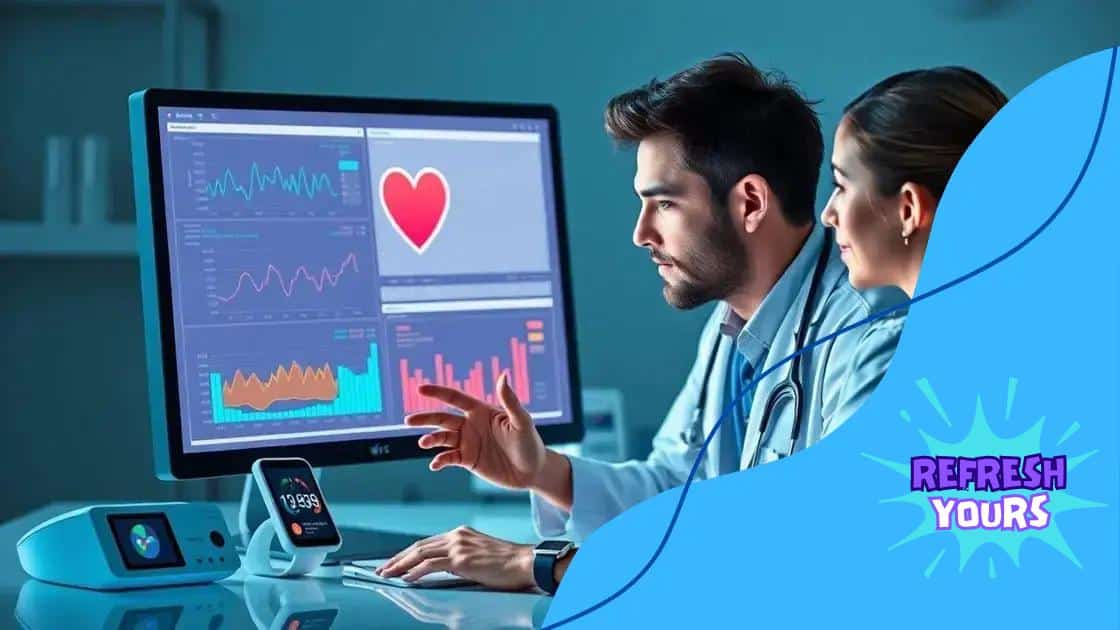The impact of smart devices on healthcare efficiency

The impact of smart devices on healthcare efficiency includes improved patient monitoring, streamlined data collection, and enhanced communication between patients and providers, driving better outcomes and accessibility.
The impact of smart devices on healthcare efficiency is reshaping how we approach patient care today. With technology evolving rapidly, it’s worth exploring how these devices improve outcomes and streamline processes.
Understanding smart devices in healthcare
Smart devices are revolutionizing the healthcare landscape. They not only assist healthcare professionals but also empower patients. These devices provide real-time data, enhance communication, and improve overall efficiency in medical practices.
Types of Smart Devices
There are various types of smart devices used in healthcare. Each plays a unique role in improving patient outcomes and operational workflows.
- Wearable monitors: These include smartwatches and fitness trackers that monitor heart rates and activity levels.
- Smartphones: Mobile apps facilitate communication between patients and doctors, simplifying reservations and access to health records.
- Telehealth solutions: Video conferencing tools allow remote consultations, making healthcare accessible from anywhere.
- Connected medical devices: Instruments like blood glucose monitors automatically sync data to electronic health records.
These innovations enhance patient monitoring and ensure timely interventions. For instance, wearables can alert patients and doctors to critical changes in health status. This proactive approach leads to better management of chronic diseases.
Benefits for Patients and Providers
Smart devices can significantly improve the healthcare experience. For patients, they provide tools for better health management at home. They also offer instant feedback and reminders for medication. For healthcare providers, these devices streamline processes and reduce administrative burdens.
Moreover, integrating smart devices into daily practice fosters better patient engagement. When patients are actively involved in their care, they tend to adhere more to treatment plans and follow up on appointments.
Understanding how these smart devices work is essential for leveraging their benefits effectively. They represent the future of healthcare efficiency, transforming how care is delivered. As technology evolves, these devices will continue to integrate more seamlessly into healthcare systems.
How smart devices enhance patient monitoring
Smart devices play a crucial role in enhancing patient monitoring. They allow healthcare professionals to track vital signs and health metrics in real time. This capability enables proactive care, potentially preventing emergencies before they arise.
Continuous Health Monitoring
Through wearables, patients can continuously monitor their health status. For example, heart rate monitors can track fluctuations and alert patients to irregularities. Additionally, devices that measure glucose levels can provide insights for diabetic patients, allowing for better management of their condition.
- Real-time alerts: Immediate notifications to patients and doctors about critical health changes.
- Data tracking: Historical data allows for analysis of trends over time, improving treatment strategies.
- Personalized care: Insights from monitoring can lead to customized treatment plans.
- Remote support: Family members can also be notified, fostering a support system at home.
By integrating these smart devices into daily routines, patients become more engaged in their health. For instance, regular feedback encourages adherence to treatment plans and helps patients to take responsibility for their well-being. Furthermore, healthcare providers can access this data to adjust medications and interventions as needed.
Improving Communication Between Patients and Providers
Smart devices enhance communication, bridging gaps between doctors and patients. Through apps, patients can directly share their health data with providers. This connection allows for immediate interventions when necessary. It also reduces the need for frequent office visits, promoting convenience for patients.
As these technologies evolve, they continue to shape patient monitoring. The integration of smart devices not only supports healthcare delivery but also empowers patients, making it a win-win for everyone involved.
The role of smart devices in data collection

Smart devices have a vital role in data collection within healthcare. They gather various types of health metrics, making it easier for both patients and providers to access and analyze important information. This capability not only improves individual care but also contributes to broader healthcare strategies.
Types of Data Collected
Smart devices can capture an array of health-related data points. For instance, wearables gather information on heart rates, steps taken, and sleep patterns. In addition, connected devices can monitor vital signs like blood pressure and oxygen levels.
- Heart rate: Continuous monitoring helps detect irregular patterns.
- Activity levels: Tracking daily movements encourages exercise and lifestyle changes.
- Sleep quality: Insights into sleep patterns can improve overall wellness.
- Blood metrics: Devices can report glucose and blood pressure readings in real time.
Accurate data collection fosters informed decision-making. Healthcare providers can use this data to adjust treatment plans effectively. For example, real-time monitoring of blood glucose levels in diabetic patients allows for immediate action if levels are too high or low.
Data Integration and Management
Another important aspect is how this data is managed and integrated into healthcare systems. Many smart devices sync data with electronic health records (EHRs), providing a comprehensive view of a patient’s health history. This integration streamlines workflows and reduces the risk of errors.
Utilizing smart devices for data collection not only enhances individual patient care. It also allows for large-scale health data analysis, helping identify trends and patterns in the population. This information can lead to improved public health strategies and interventions.
Challenges of integrating smart devices
Integrating smart devices into healthcare is not without its challenges. While these devices offer significant benefits, there are obstacles that must be addressed to maximize their efficiency and effectiveness. Understanding these challenges is crucial for successful implementation.
Data Security and Privacy
One major concern is the security of patient data. As smart devices collect sensitive health information, they become targets for cyberattacks. Protecting this data is vital to maintain patient trust and comply with regulations such as HIPAA.
- Encryption: Implementing strong encryption methods can safeguard data both during transmission and storage.
- Access controls: Limiting access to sensitive information prevents unauthorized use.
- Regular updates: Keeping devices and software updated minimizes vulnerabilities.
- Training staff: Educating healthcare workers on data security best practices fosters a culture of awareness.
Without addressing these security concerns, the potential of smart devices may be undermined.
Interoperability Issues
An additional challenge is interoperability between different devices and healthcare systems. Not all smart devices can easily communicate with each other or with existing systems, leading to fragmented data. This can hinder the flow of information and reduce the effectiveness of care.
To improve interoperability, standardized protocols must be established. This ensures that devices can exchange data effectively, allowing healthcare providers to gain comprehensive insights into patient health. Furthermore, better integration can lead to streamlined workflows and improved patient outcomes.
Moreover, training healthcare professionals to effectively use and manage these smart devices is essential. Even with excellent technology, if staff are not comfortable or familiar with the tools, the integration will not be successful. Supporting staff through training can bridge knowledge gaps and promote confidence in utilizing smart devices.
Future trends in healthcare technology
The future of healthcare technology is promising, driven by advancements in smart devices and artificial intelligence. As technology evolves, we can expect to see significant changes that enhance patient care and operational efficiency.
Telemedicine Expansion
One major trend is the expansion of telemedicine. This enables doctors to consult with patients remotely, breaking geographical barriers. With increased access to healthcare services, more patients can receive timely care without traveling long distances.
- Convenience: Patients can attend appointments from home, saving time and resources.
- Broader reach: Rural and underserved populations can access specialists.
- Cost-effective: Reduces overhead for healthcare providers and travel costs for patients.
- Enhanced data collection: Telemedicine platforms can integrate smart devices for real-time health monitoring.
As telemedicine grows, we can expect improvements in technology to support these services, making them even more effective.
Artificial Intelligence and Data Analytics
Another prominent trend is the integration of artificial intelligence (AI) and data analytics. AI can help in predicting health outcomes and personalizing treatment plans. By analyzing large datasets, healthcare providers gain insights that guide decision-making.
This technology allows for faster diagnoses and improved treatment strategies. Machine learning algorithms can identify patterns in patient data, leading to tailored therapies. Furthermore, AI can streamline administrative tasks, freeing up healthcare professionals to focus more on patient care.
Moreover, the Internet of Things (IoT) is also set to play a significant role. Connected devices will work together to provide comprehensive health monitoring, creating a more integrated healthcare ecosystem. As these technologies develop, they will continue to empower patients and healthcare providers alike.
FAQ – Frequently Asked Questions about Smart Devices in Healthcare
How do smart devices improve patient monitoring?
Smart devices allow for continuous health tracking, enabling instant alerts and real-time insights for better patient care.
What role does telemedicine play in healthcare today?
Telemedicine provides remote consultations, making healthcare more accessible for patients, especially in remote areas.
What challenges do smart devices face in healthcare integration?
Key challenges include data security concerns, interoperability issues, and the need for proper training of healthcare staff.
How can AI enhance healthcare services?
AI can analyze data to personalize treatment plans, improve diagnosis accuracy, and streamline administrative tasks.





